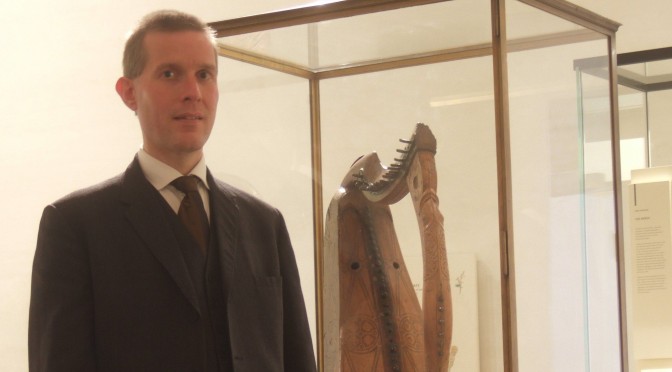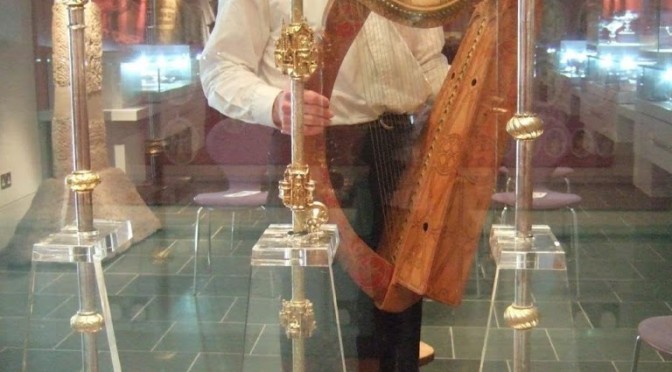I am working hard this week, preparing for three events in three days. On Saturday I am in Dundee; on Sunday in St Andrews and on Monday in London.
Tag: MUSA
Medieval Maces in the Museum
Here’s a photo taken by one of the Museum staff, of my concert the other week.
The turnout was bigger than I had expected, at least 50 people in what is a fairly small gallery space. As usual I was slightly nervous of presenting the big, complex, intricate ceòl mór style pieces to a general audience, but afterwards people came up to me and said that the piece they loved best was Caniad San Silin – about 13 minutes of repetitive geometric variations.
For me it was such a thrill to present the music in this glorious setting. I chose pieces that were closely connected in to late Medieval contexts, all of them secular instrumental tunes. The structure and style of the music really fitted well with the decoration and craftsmanship of the medieval maces.
You can see some of the maces behind me. From left to right, Glasgow, Heidelberg x 2, Tübingen, Erfurt, and Bishop Fox’s crozier from Corpus, Oxford.
Dammit they are just so shiney!
Glasgow University mace
This engraving from Brook’s 1892 article in PSAS about the medieval Scottish university maces shows the head of the Glasgow mace, which was made in Scotland in the 1460s. When I was in the exhibition in MUSA looking at this mace, I was struck by the foliage designs on the panels in the central stage (these six panels are illustrated on the engraving).
The leaves on these lovely engraved silver plates are similar to the late 15th century forepillar leaves on the Queen Mary harp, However the leaves on the mace are not identical, and to me they looked a bit later. There are similar leaves on the 16th century Ballinderry harp metalwork.
Brook suggests that the plates are not original to the 1460s construction of the mace, but may have been late 16th century post-reformation replacements of figures of saints. The St Andrews Arts mace and Canon law mace both have very similar designs and both have saints in these middle panels.
The leaves are not easy to see on the mace in the museum as they are above eye level and the silver is very highly polished. However I am looking forward to comparing them with the leaves on my replica of the Queen Mary harp at my concert tomorrow.
Heraldry
This drawing is from Alexander Brook’s 1892 article in PSAS, on the maces of the Scottish Universities. It is a drawing of two of the six heraldic shields on St Andrews Arts faculty mace.
The one on the right, no. IV, shows the arms of Alexander Stewart, Earl of Mar (c.1375-1435). I don’t know what his connection is with the University of St Andrews, though he witnessed a royal confirmation of the University’s charter in 1432. The University started in 1411; the shield was presumably made and affixed to the mace on its completion in about 1416.
The Earl of Mar led the Royalist army at the Battle of Harlaw in 1411. It is fascinating to me to trace these connections. I will point out this coincidence in my concert on Sunday, when I will play the ceòl mór variation set of Cath Gairbheach (the Battle of Harlaw). Unfortunately the side of the Arts Faculty mace that has Mar’s shield is facing away from the centre of the exhibition room, but you can see it OK if you go round the other side of the case.
Power & Ceremony: the medieval university maces
Today I was at the Museum of the University of St Andrews, to look at the exhibition of medieval university maces.
The three 15th century gold and silver maces that belong to the University of St Andrews have long been favourites of mine, and I have performed in front of them at the museum. So I was delighted when the museum organised an exhibition of other medieval maces from universities across Europe, and I was honoured when they invited me to do a concert as part of the exhibition.
The exhibition is in the biggest room in the museum, and has three large standing glass cases, each containing three maces. There are the three St Andrews ones of course; there is the one from Glasgow; two from Heidelberg; one from Erfurt, one from Tübingen and one from Basel. There is also the outrageous medieval gold crozier of Bishop Fox, who founded Corpus in Oxford.
All of these are stunning art objects from 15th century master craftsmen, and it also fascinates me that many of them remain in regular use – the display panels include photographs of the various maces being carried in procession in front of dignitaries. The maces are all very delicately decorated with architectural, figurative, foliate and geometrical motifs. I was most interested to see comparisons with the 15th century carvings on the pillar of the Queen Mary harp – I think it will be quite an experience to take my replica in there and see it next to all these medieval artworks.
My concert is on Sunday 13th October at 2pm. I’ll be playing a programme of medieval ceremonial music, mostly Scottish, and will try to connect the music in with the objects on display.
The exhibition runs until the 8th December – if you have a chance to visit I would strongly recommend it!
Blue Stane & Black Stone
There are two interesting stanes in St Andrews, and the other day I went and photographed both of them for you.
The Black Stone is on display in a glass case in the Museum of the University of St Andrews, though I remember years ago before the museum was opened, seeing the Black Stone standing in the big fireplace in Parliament Hall, below the old library. Apparently it used to be used as the ritual seat on which MA candidates would be seated, for their oral examination, and it was used for this purpose from c.1420 (when the University was brand new) through to the 18th century. It looks like it may be a Roman pillar capital; the bands are gilded, and it is extremely black. It is obviously connected to other ritual stone seats such as the Stone of Scone at Edinburgh Castle, and the Frith Stool in Hexham Cathedral.
The Blue Stane stands behind high railings, outside a pub of the same name, on one of the roundabouts on City Road, a hundred yards or so outside one of the old medieval gates of the city. It has moved around a bit over the centuries (since its first appearance on a 1580 map) but has always been beside a road outside the West end of the city. It is a kind of Dolerite from Drumcarrow Craig a few miles west. In olden times, men would pat it and women curtsey to it as they passed. It is said to have been King Kenneth MacAlpine’s coronation seat in the 9th century. Apparently there is another blue stane outside of Crail kirk but I have not seen that one.











